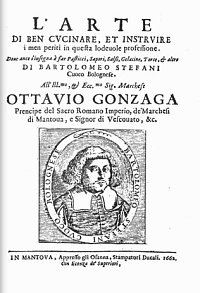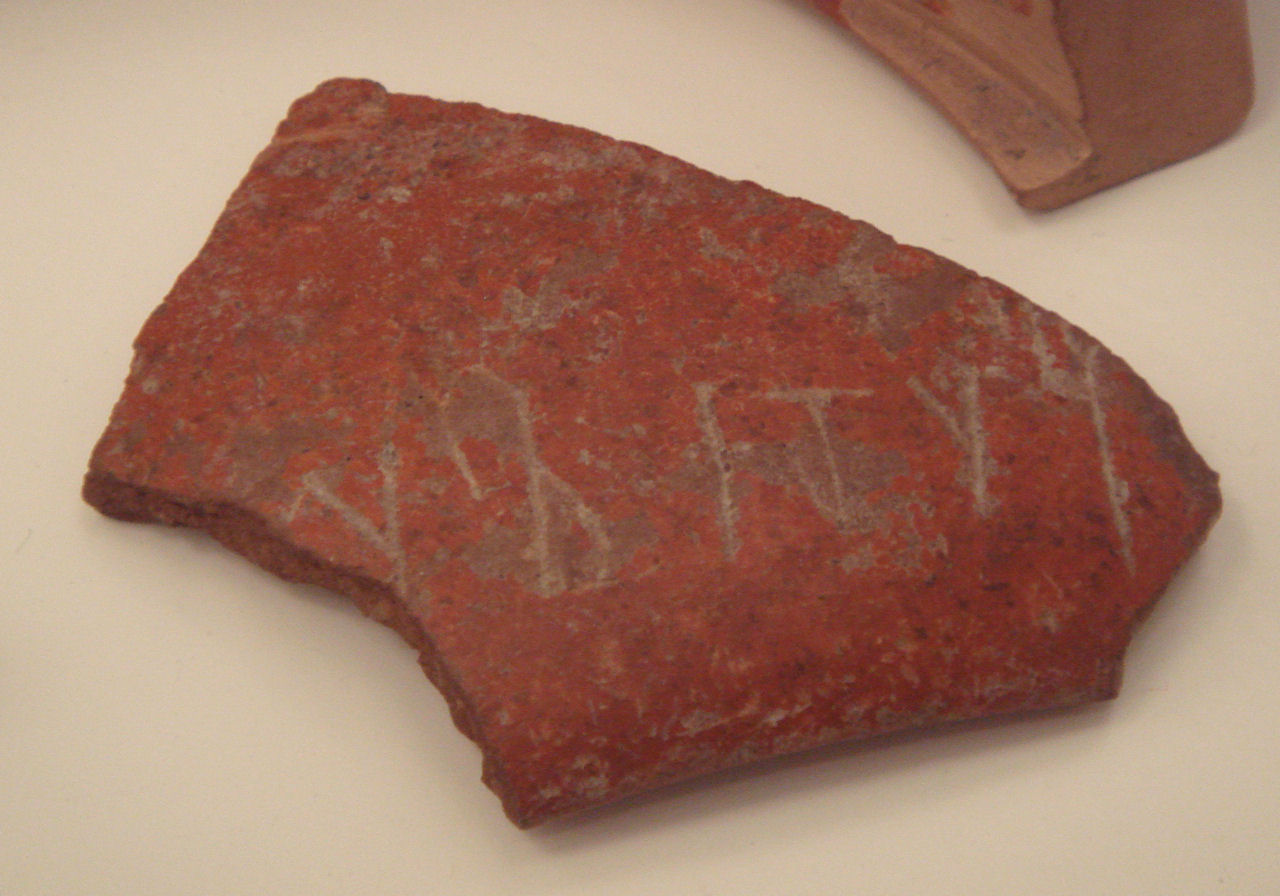|
Tortelli
Tortelli is a type of filled pasta traditionally made in the Lombardy, Emilia-Romagna, and Tuscany regions of Italy. It can be found in several shapes, including square (similar to ravioli), semi-circular (similar to agnolini), or twisted into a rounded, hat-like form (similar to cappelletti (pasta)). It can be served with melted butter, bolognese sauce, broth, or other sauces. The same word is also used to describe small, fried pastries filled with jam or cream. Ricotta tortelli, served with butter and herbs, is a popular dish in Romagna. Other typical dishes include tortelli with pumpkin (common in Mantua, Reggio Emilia, Piacenza, and Cremona) and tortelli di parma (from Parma), with ricotta and herbs, spinach, potatoes, or pumpkin. Many popular forms of tortelli can be found in Tuscany. Tortello del Melo is typical in Pistoia. Potato torricelli is popular in Arezzo, Florence, and Prato. Maremma is known for an unusually large form of tortelli with ricotta and spinach. ... [...More Info...] [...Related Items...] OR: [Wikipedia] [Google] [Baidu] |
Lombardy
(man), (woman) lmo, lumbard, links=no (man), (woman) , population_note = , population_blank1_title = , population_blank1 = , demographics_type1 = , demographics1_footnotes = , demographics1_title1 = , demographics1_info1 = , demographics1_title2 = , demographics1_info2 = , demographics1_title3 = , demographics1_info3 = , timezone1 = CET , utc_offset1 = +1 , timezone1_DST = CEST , utc_offset1_DST = +2 , postal_code_type = , postal_code = , area_code_type = ISO 3166 code , area_code = IT-25 , blank_name_sec1 = GDP (PPS) , blank_info_sec1 = €401 billion (2019) , blank1_name_sec1 = GDP per capita , blank1_info_sec1 = €39,700 (2019) $51,666 (2016) (PPP) , blank2_name_sec1 = HDI (2019) , blank2_info_sec1 = 0.912 · 4th of 21 , blank_name_sec2 ... [...More Info...] [...Related Items...] OR: [Wikipedia] [Google] [Baidu] |
Parma
Parma (; egl, Pärma, ) is a city in the northern Italian region of Emilia-Romagna known for its architecture, music, art, prosciutto (ham), cheese and surrounding countryside. With a population of 198,292 inhabitants, Parma is the second most populous city in Emilia-Romagna after Bologna, the region's capital. The city is home to the University of Parma, one of the oldest universities in the world. Parma is divided into two parts by the stream of the same name. The district on the far side of the river is ''Oltretorrente''. Parma's Etruscan name was adapted by Romans to describe the round shield called '' Parma''. The Italian poet Attilio Bertolucci (born in a hamlet in the countryside) wrote: "As a capital city it had to have a river. As a little capital it received a stream, which is often dry", with reference to the time when the city was capital of the independent Duchy of Parma. History Prehistory Parma was already a built-up area in the Bronze Age. In the curr ... [...More Info...] [...Related Items...] OR: [Wikipedia] [Google] [Baidu] |
Emilia-Romagna
egl, Emigliàn (man) egl, Emiglièna (woman) rgn, Rumagnòl (man) rgn, Rumagnòla (woman) it, Emiliano (man) it, Emiliana (woman) or it, Romagnolo (man) it, Romagnola (woman) , population_note = , population_blank1_title = , population_blank1 = , demographics_type1 = , demographics1_footnotes = , demographics1_title1 = , demographics1_info1 = , demographics1_title2 = , demographics1_info2 = , demographics1_title3 = , demographics1_info3 = , timezone1 = CET , utc_offset1 = +1 , timezone1_DST = CEST , utc_offset1_DST = +2 , postal_code_type = , postal_code = , area_code_type = ISO 3166 code , area_code = IT-45 , blank_name_sec1 = GDP (nominal) , blank_info_s ... [...More Info...] [...Related Items...] OR: [Wikipedia] [Google] [Baidu] |
Ravioli
Ravioli (; singular: ''raviolo'', ) are a type of pasta comprising a filling enveloped in thin pasta dough. Usually served in broth or with a sauce, they originated as a traditional food in Italian cuisine. Ravioli are commonly square, though other forms are also used, including circular and semi-circular (mezzelune). The word 'ravioli' means "little turnips" in Italian dialect, from the Italian ''rava'' meaning turnips, from the Latin ''rapa''. History The earliest known mention of ravioli appears in the personal letters of Francesco di Marco Datini, a merchant of Prato in the 14th century.Davidson ''Oxford Companion to Food'', p. 655. In Venice, the mid-14th-century manuscript ''Libro per cuoco'' offers ravioli of green herbs blanched and minced, mixed with beaten egg and fresh cheese, simmered in broth and seasoned with "sweet and strong spices". In Rome, ravioli were already well known when Bartolomeo Scappi served them with boiled chicken to the papal conclave of ... [...More Info...] [...Related Items...] OR: [Wikipedia] [Google] [Baidu] |
Agnolini
Agnolini are a type of stuffed egg pasta originating from the province of Mantua (in the Mantuan dialect they are commonly called "agnulìn" or "agnulì") and are oftentimes eaten in soup or broth. The recipe for Agnolotti was first published in 1662 by Bartolomeo Stefani, a cook at the court of the Gonzaga family, in his book '' The art of cooking well''. Agnolini's recipe is passed down from generation to generation by Mantuan families. Agnolini are the main ingredient of soups of the Mantuan cuisine, usually consumed during holidays and important occasions. According to Mantuan tradition during Christmas Eve chicken broth with the Agnolini alongside other traditional Mantuan dishes such as the Agnolini's soup Sorbir d'agnoli, with abundant addition of parmesan cheese are consumed. Sorbir, to which red wine is added, generally Lambrusco, represents the opening to the Christmas lunch. Agnolini differ from the classic Emilian tortellini, to which they are similar, due to ... [...More Info...] [...Related Items...] OR: [Wikipedia] [Google] [Baidu] |
Cappelletti (pasta)
''Cappelletti'' are ring-shaped Italian pasta so called for the characteristic shape that resembles a hat (''cappello'' in Italian). Compared to ''tortellini'', they have a different shape, larger size, thicker dough and different filling. The origins of the recipe, very widespread on a territorial basis, are ancient, traditionally and historically linked to Emilia-Romagna and Marche.Cristina Ortolani, ''L'Italia della pasta'', Touring Editore, 2003, p. 86, ISBN 9788836529339. From these areas it then spread over the centuries, becoming a typical dish in various cities. Some recent sources specifically indicate the area in the Cesena-Ferrara-Reggio Emilia triangle as the place of origin, others report the Marche as a land where ''cappelletti'' are of ancient tradition. Production areas Emilia A first reference to this culinary preparation could perhaps be found linked to Ferrara, in a text dating back to 1556 by Cristoforo di Messisbugo, former cook of the Este court with Alfon ... [...More Info...] [...Related Items...] OR: [Wikipedia] [Google] [Baidu] |
Prato
Prato ( , ) is a city and ''comune'' in Tuscany, Italy, the capital of the Province of Prato. The city lies in the north east of Tuscany, at the foot of Monte Retaia, elevation , the last peak in the Calvana chain. With more than 200,000 inhabitants, Prato is Tuscany's second largest city (after Florence) and the third largest in Central Italy (after Rome and Florence). Historically, Prato's economy has been based on the textile industry and its district is the largest in Europe. The textile district of Prato is made up of about 7000 fashion companies, obtaining around 2 billion euros from exports. The renowned Datini archives are a significant collection of late medieval documents concerning economic and trade history, produced between 1363 and 1410. The city boasts important historical and artistic attractions, with a cultural span that started with the Etruscans and then expanded in the Middle Ages and reached its peak with the Renaissance, when artists such as Donate ... [...More Info...] [...Related Items...] OR: [Wikipedia] [Google] [Baidu] |
Pistoia
Pistoia (, is a city and ''comune'' in the Italian region of Tuscany, the capital of a province of the same name, located about west and north of Florence and is crossed by the Ombrone Pistoiese, a tributary of the River Arno. It is a typical Italian medieval city, and it attracts many tourists, especially in the summer. The city is famous throughout Europe for its plant nurseries. History ''Pistoria'' (in Latin other possible forms are ''Pistorium'' or ''Pistoriae'') was a centre of Gallic, Ligurian and Etruscan settlements before becoming a Roman colony in the 6th century BC, along the important road Via Cassia: in 62 BC the demagogue Catiline and his fellow conspirators were slain nearby. From the 5th century the city was a bishopric, and during the Lombardic kingdom it was a royal city and had several privileges. Pistoia's most splendid age began in 1177 when it proclaimed itself a free commune: in the following years it became an important political centre, ... [...More Info...] [...Related Items...] OR: [Wikipedia] [Google] [Baidu] |
Arezzo
Arezzo ( , , ) , also ; ett, 𐌀𐌓𐌉𐌕𐌉𐌌, Aritim. is a city and ''comune'' in Italy and the capital of the Province of Arezzo, province of the same name located in Tuscany. Arezzo is about southeast of Florence at an elevation of Above mean sea level, above sea level. As of 2022, the population was about 97,000. Known as the city of gold and of the high fashion, Arezzo was home to artists and poets such as Giorgio Vasari, Guido of Arezzo and Guittone d'Arezzo and in its Province of Arezzo, province to Renaissance artist Michelangelo. In the artistic field, the city is famous for the frescoes by Piero della Francesca inside the Basilica of San Francesco, Arezzo, Basilica of San Francesco, and the crucifix by Cimabue inside the Basilica of San Domenico, Arezzo, Basilica of San Domenico. The city is also known for the important Giostra del Saracino, a game of chivalry that dates back to the Middle Ages. History Described by Livy as one of the ''Capita Etruriae'' ... [...More Info...] [...Related Items...] OR: [Wikipedia] [Google] [Baidu] |
Florence
Florence ( ; it, Firenze ) is a city in Central Italy and the capital city of the Tuscany region. It is the most populated city in Tuscany, with 383,083 inhabitants in 2016, and over 1,520,000 in its metropolitan area.Bilancio demografico anno 2013, datISTAT/ref> Florence was a centre of medieval European trade and finance and one of the wealthiest cities of that era. It is considered by many academics to have been the birthplace of the Renaissance, becoming a major artistic, cultural, commercial, political, economic and financial center. During this time, Florence rose to a position of enormous influence in Italy, Europe, and beyond. Its turbulent political history includes periods of rule by the powerful Medici family and numerous religious and republican revolutions. From 1865 to 1871 the city served as the capital of the Kingdom of Italy (established in 1861). The Florentine dialect forms the base of Standard Italian and it became the language of culture throug ... [...More Info...] [...Related Items...] OR: [Wikipedia] [Google] [Baidu] |
Piatto Tipico Con Tortelli Caserecci Conditi Con Funghi Prugnoli E Pecorino Di Sasso Pisano (PI)
Piatto is a ''comune'' (municipality) in the Province of Biella in the Italian region Piedmont, located about northeast of Turin and about northwest of Biella. On 31 December 2004, it had a population of 527 and an area of .All demographics and other statistics: Italian statistical institute Istat. Piatto borders the municipalities of Bioglio, Callabiana, Camandona, Mosso, Quaregna Quaregna was a ''comune'' (municipality) in the Province of Biella in the Italian region Piedmont, located about northeast of Turin and about northwest of Biella. As of 31 December 2004, it had a population of 1,325 and an area of .All demograph ..., Ternengo, Valdengo, Vallanzengo, Valle San Nicolao and Veglio. Demographic evolution Colors= id:lightgrey value:gray(0.9) id:darkgrey value:gray(0.8) id:sfondo value:rgb(1,1,1) id:barra value:rgb(0.6,0.7,0.8) ImageSize = width:455 height:303 PlotArea = left:50 bottom:50 top:30 right:30 DateFormat = x.y Period = from:0 till: ... [...More Info...] [...Related Items...] OR: [Wikipedia] [Google] [Baidu] |






